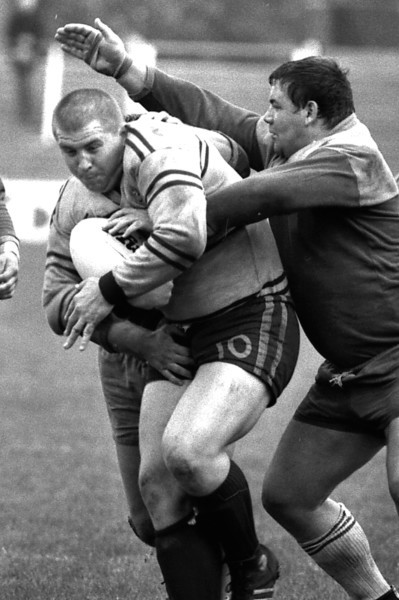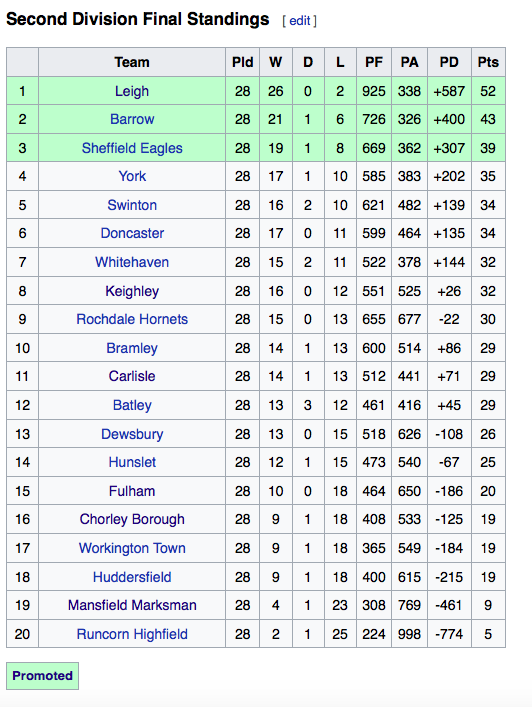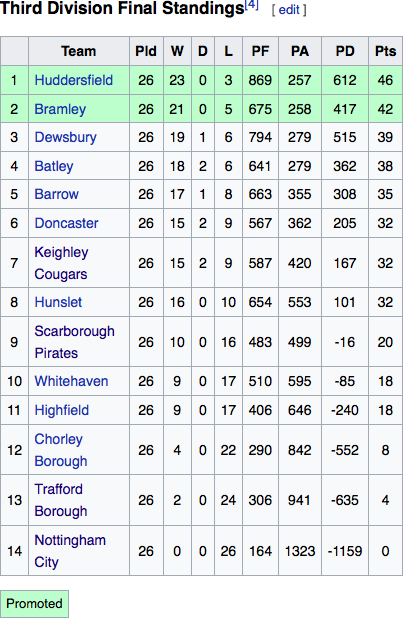The story starts in the 1980s when Rugby League was undergoing an expansion outside of its conventional northern setting.
Mansfield was chosen as an area in the heartland of the Nottinghamshire coalfields, with great access to Yorkshire and surrounding Counties and therefore a great contender for spectator sport.

With the Mansfield Brewery’s popular lager as the main sponsor it was thought that support would flood in and so planted roots at Field Mill.

Their pre-season games in the midst of the ongoing miners’ strike saw the team play the biggest names in rugby league including St Helens and Wigan, but suffered heavy defeats.
t was also reported that during the pre-season games, the most prominent names in the team were on holiday, creating opportunities for local players to take stage.
Already there was doubts that professional rugby league wasn’t being taken seriously in the town.
The first Division Two match for the Marksman saw an attendance of 2,291 against Wakefield in a 15-0 win.

When it mattered most the Marksman could pull off the results to keep media support rolling in even if it was scarce.
However, despite the Marksman success on the field, attendances declined weekly.
In the second half of the season when results weren’t consistent attendances dropped to just a few hundred.

Of course the slump in the Marksmen’s first season of existence had financial implications. It was reported that the team had suffered a loss of a staggering £90,000.
In their first season (1984/85) they finished a respectable 9th in the table

In 1986 the Marksmen made the move from Field Mill to Alfreton Town FC, but then later moved to Sutton Town’s ground. Finally the Mansfield Marksmen made their resting place at Nottingham’s Harvey Hadden stadium in 1989, but soon became Nottingham City RLFC. Just how did it go so wrong for a team who had so much potential?

The move to an area where the sport is virtually non-existent was a great risk. Much more could have been done make Mansfield more aware of the sport and educate people in what rugby league is all about. Perhaps there was no room in Mansfield for two professional sports teams or perhaps it was just the wrong time to drop a team in Mansfield during a period of conflict in the area. If there had been a thriving amateur scene in the area there’s a possibility it may have taken off better.

Mansfield Marksman RLFC
Mansfield Marksman was founded in 1984 and joined the Second Division along with Sheffield Eagles, in 1984-85. Mansfield was chosen as it was in the heartland of the Nottinghamshire coalfields, and close to Yorkshire where rugby league was much stronger.
Their General Manager was Dave Parker, a rugby league journalist. They played initially at Mansfield Towns Field Mill, and were sponsored by Mansfield Brewery and named “Marksman” in the singular after a lager the brewery produced. The club colours were predominantly sky blue and dark blue shirts with yellow trim, however towards the end of their existence the club colours became a more basic blue and amber. The team was composed of northern, mainly West Yorkshire based players, who travelled down to play for Mansfield.
Mansfield’s pre-season friendlies saw them play some of the strongest teams in British rugby league, including St Helens and Wigan. Unfortunately Mansfield’s big name players were on holiday and a weakened team, including many local players, went down to heavy defeats.
Mansfield first home game in the Second Division attracted 2,291 spectators and they defeated Wakefield Trinity 15-0. They won eight of their first nine games; the only defeat being 7-6 at Dewsbury. However, they struggled after this and attendances declined steadily. Their final home game of the season against Rochdale Hornets was watched by 321 spectators and they were beaten 9-8. The club lost £90,000 in this first year and could not afford the rent at Field Mill. The final game there was on 2 February 1986 when Marksman lost 32-2 to Leigh.
The club then moved to Alfreton Towns North Street stadium. The first game at the new venue was on 23 March 1986 when Mansfield were beaten 42-18 by Workington Town in front of a crowd of 290.
The club moved once again for the 1988-89 season to Sutton Towns Lowmoor Road ground at Kirkby in Ashfield
Table for 1985/86 where the Marksman finished bottom

1986/87 below

1987/88 below

1988/89 below

Nottingham City RLFC
A boardroom split occurred over the decision to move the club to Nottingham in June 1989. The move also led to the loss of sponsorship by Mansfield Brewery and the club was renamed Nottingham City RLFC. They played at the Harvey Hadden Stadium and their initial club colours were sky blue shirts with a dark blue and gold vee, carrying over the Mansfield Marksman colours. Later the club colours changed to myrtle green, yellow and white shirts (see 1991/92 shirt in these colours below under the 91/92 table). In later years the shirts were myrtle green with purple trim. One season the team adopted the name Nottingham City Outlaws RLFC, a name that would later be used by the city amateur side.
Shirt below from 1989/90

The Nottingham team was led by player-coach Mark Burgess, several players were from Batley Boys RLFC and other local towns, Dave Parker took over as Managing Director at Huddersfield and the Nottingham City club was run by former Mansfield Director Paul Tomlinson and his mother Joan. As Nottingham they won only seven games in four years.
Their first season in the Second Division 1989/90 table below

Chief Executive Maurice Lindsay wanted to reduce the number of clubs in the lower division of the league in 1993. The three clubs finishing bottom of the second division would be demoted to the National Conference League . Nottingham struggled and finished bottom of the Third Division at the end of the 1992-93 season, winning only one game. With both Nottingham City and Blackpool Gladiators both already relegated, the crucial last match at Nottingham on 12 April 1993, between Nottingham City and Highfield would determine the final relegation spot. Highfield won 39-6 and Highfield survived at the expense of Chorley Borough
The RLSA, the Rugby League Supporters Association, had called on fans to turn out at the Harvey Haddon Stadium in protest against the decision, City’s normal crowd of three hundred or so was boosted by this to a season’s best of 851.[The three expelled clubs plus Highfield RL pursued legal action against the RFL decision, but to no avail.
Nottingham could no longer afford Yorkshire-based players so imported local Nottingham Crusaders players who weren’t up to National Conference League standards and they were relegated in their first year and then resigned from the league the following year.
Table 1990/91

For the 1991/92 season there were 3 divisions but Nottingham City came bottom again

This season they used a Canterbury shirt

The 1992/93 table, their last

It’s Harvey Hadden – not Haddon – Stadium.
LikeLike